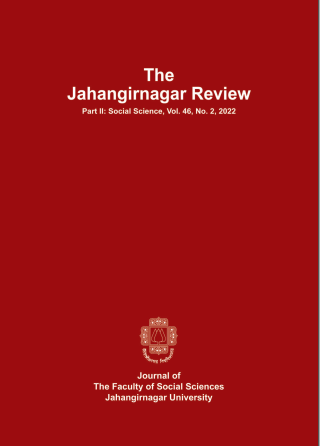Institutional Roles in Effective Management of Flood Disaster Risks and Policy Implications in Bangladesh
Main Article Content
Abstract
Bangladesh is widely known as a disaster-prone country in the world and experiencing increased floods, cyclones, and droughts for hundreds of years resulting in huge damages to properties and loss of life. The geographical location, land characteristics, multiplicity of rivers, and monsoon climate render the country to frequent natural hazards and vulnerabilities. Causes of floods are natural and mostly human-induced (Nishat 2004, Brammer 2010:4, FFWC 2012, Zaman 2012, and Rahman, et.al. 2009). Natural and human induced causes include unplanned urbanization, riverbed aggradations, deterioration of drainage channels, soil erosion, deforestation in the upstream region, subsidence and compaction of sediments, impact of embankments constructed elsewhere, local relative sea-level rise, global climate change, tidal waves/effect, etc. IPCC (2007) considered anthropogenic causes for rapid climate change and increased climatic extreme causing damage/degradation to nature and the environment. Flash floods, river floods, rain floods, and storm surge floods are prevalent in Bangladesh, with different management approachesi (NPDM 2010-2015, p-4). The Hyogo Framework for Action, UNFCC, IPCC (2007) identified Bangladesh as one of the most vulnerable countries to climate change and ranked as the 1st country (among 162 countries) in the World Risk Index for flood. According to the World Risk Report Bangladesh is ranked as the 5th country in the World Risk Index (out of 162 countries)for floods in the world, while, 6th (of 89) for cyclones, 3rd (of 76) for Tsunami, and 63rd (of 184) for drought (WRR 2012). he disaster risk management/ reduction, mitigation, and adaptation to limate change are linked and should be effectively integrated in a planned way to reduce its risks/vulnerability.
This was an anthropological study conducted in Daskandi and Karmakerkandi villages of Boyra Union under Harirampur Upazila of Manikganj District- highly prone to riverine flood since its situation beside the bank of the mighty river ‘The Padma’ in the central floodplains. A qualitative approach was used mainly with little a quantitative approach. A total of 25 households with different occupationsii and social groups including key informantsiii were selected for the research, where ‘household’ was the study unit. Categories of respondents included both primary and secondary sources. The qualitative approach included 25 in-depth interviews, 16 case studies, and 03 focus group discussions (male/female/mixed). Quantitative methods included a survey of all 273 households (Daskandi-162, Karmakerkandi-111) to prepare the village profiles. In-depth interviews took 5-7 attempts/household on different days. Besides consulted representatives of LGIsiv including several national-level researchers, academics, practitioners specialized/experienced in disaster risks management.

